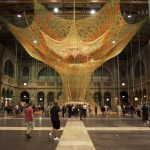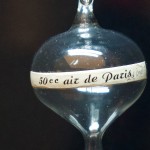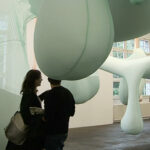Until the end of June, the Fondation Beyeler is showing the pubic art project GaiaMotherTree by the Brazilian artist Ernesto Neto in Zürich’s Main Train Station. GaiaMotherTree is a monumental sculpture made of brightly colored hand-knotted cotton strips. It resembles a tall tree and extends right up to the ceiling of the station concourse, which is twenty meters high. Ernesto Neto’s GaiaMotherTree is not only a sculpture, but also a walk-in structure that functions as a meeting place and a venue for interaction and meditation. A program of events takes place inside the installation, including concerts, workshops, talks, and guided tours. This video provides you with some impressions of the opening event.
Ernesto Neto: GaiaMotherTree / Fondation Beyeler at Zürich Main Station. Zürich, Switzerland, June 29, 2018.
> Right-click (Mac: ctrl-click) this link to download Quicktime video file.
Press text:
In June and July 2018, the Fondation Beyeler will be showing an installation by the Brazilian artist Ernesto Neto (b. 1964 in Rio de Janeiro) in Zurich Main station. The monumental work GaiaMotherTree, a sculpture made of brightly colored hand-knotted cotton strips, resembles a tall tree, extending right up to the ceiling of the station concourse, which is twenty meters high. It is a walk-in structure that functions as a meeting place and a venue for interaction and meditation. A varied program of events for adults and children, with music, workshops, guided tours and talks, will take place inside the installation.
Ernesto Neto is one of Latin America’s most important contemporary artists. His work, comprising sculptures, installations and multimedia projects, has won worldwide recognition, with several presentations at the Venice Biennale and exhibitions in the world’s leading museums. It has been collected by, among others, the Museum of Modern Art and the Solomon R. Guggenheim Museum, New York; the Tate Modern, London; the Centre Pompidou, Paris; and the Hara Museum, Tokyo.
Neto’s ideas have been influenced by the Brazilian Neo-Concrete movement of the 1960s and also by Minimal and Conceptual Art, and Arte Povera. Spirituality, humanism, and ecology are among his principal concerns. His work since the 1990s has been characterized by the use of unusual materials and techniques. His sculptures and installations often feature biomorphic forms and organic materials, with transparency and sensuality playing a major role. Viewers can touch the works and walk through them or set them in motion; in many cases, they also appeal to the sense of smell. The visitor is invited to concentrate on his or her own perception and interact with the work and its environment.
In recent years, Neto has turned his attention to a new series of works, which he is realizing in cooperation with the Huni Kuin, an indigenous community living in the Amazon region near the Brazilian border with Peru. The culture and customs of the Huni Kuin, their knowledge and craft skills, their aesthetic sense, their values, their world view, and their spiritual connection with nature, have transformed Neto’s conception of art and become integral elements of his artistic practice.
GaiaMotherTree was made entirely by hand. Strips of cotton were colored with natural dyes, and then knotted together with a finger-crocheting technique to form a giant transparent structure. The upper part of the work, shaped like the crown of a tree, will cover the ceiling of the station concourse. At the base of the tree there is a large space where visitors can linger and rest on seats arranged in a circle. Drop-shaped elements hanging from the branches are filled with aromatic spices and dried leaves.






